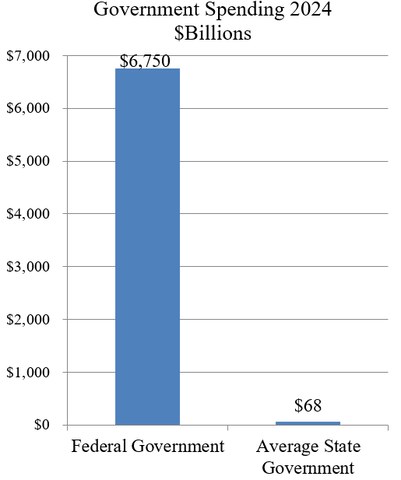Chris Edwards and Krit Chanwong
Federal spending and deficits are at dangerously high levels, and interest costs on government borrowing are soaring. If spending is not restrained, we may face an economic crisis. Congress should cut spending, and one good reform target is the huge and fast‐growing Medicaid program.
Medicaid provides health coverage for lower‐income individuals. It is administered by the states but the federal government provides about two‐thirds of the funding. Federal Medicaid costs have more than doubled over the past decade from $265 billion in 2013 to $616 billion in 2023.
The federal government funds Medicaid with open‐ended matching payments to the states. For administrative costs, the federal match averages 62 percent, and for medical costs the match is based on the Federal Medical Assistance Percentage. The FMAP is determined by each state’s per capita income—states with lower incomes receive higher matches and states with higher incomes receive lower matches. State FMAPs range from 50 to 83 percent.
The national average FMAP in coming years is expected to be 60 percent. That means for every $10 million that states expand their Medicaid programs, they pay $4 million and they send a bill to Washington for $6 million.
However, the federal match is even higher on Medicaid enrollees under the 2010 Affordable Care Act. The Act provides a 90 percent match to states that expand coverage to all adults under age 65 up to 138 percent of the poverty level. That creates a large incentive for states to join the ACA expansion and 40 states have done so.
The cost of the ACA expansion exceeded projections. A 2016 study found that enrollment in 24 early adopting states was double than originally projected. New York projected 76,000 ACA enrollees by 2015 but actual enrollment was 285,000. California projected 910,000 enrollees by 2016 but actual enrollment was 3.8 million.
Federal subsidies for the states create many distortions, which high federal matching rates exacerbate. A modest first step to reform Medicaid would be to reduce the ACA matching rate. The ACA expansion is now costing federal taxpayers about $120 billion a year.
Bad Incentives of Federal Funding
If a state with an FMAP of 60 percent expands its Medicaid by $10 million, it would cover $4 million and the federal government would cover $6 million. This creates an incentive for states to expand benefits beyond what they would provide if state taxpayers paid the full cost. Medicaid expansion allows state policymakers to spend on their constituents while only being accountable to their constituents for a fraction of the costs.
Also, as Michael Cannon noted, if a state spends, say, $4 million on an activity such as policing that does not receive matching federal aid, it buys $4 million of police protection. But if a state spends $4 million on Medicaid, it buys $10 million in health care spending. So federal aid distorts the legislative priorities of state policymakers, and public funds are misallocated.
Furthermore, Medicaid’s high federal match combined with the program’s size and complexity undermines state‐level monitoring for waste and fraud. For every $10 million that state auditors may save from reducing waste or fraud in a state with a 60 percent match, the state government would gain just $4 million. As a result, states likely underinvest in program integrity activities such as examining billing claims and recipient eligibility.
Medicaid has long been on the Government Accountability Office’s high‐risk list. The program’s improper payment rate was 16 percent in 2022, which amounted to $81 billion of erroneous or fraudulent payments. Some legislators think the rate is substantially higher.
State governments themselves abuse Medicaid with schemes to inflate matching dollars. To boost their federal match, they classify non‐Medicaid spending as Medicaid spending, and they create accounting schemes such as overpaying health care facilities run by local governments and imposing taxes on health providers.
Medicaid’s financial structure creates irresponsibility all around. Budget expert James Capretta noted, “Medicaid’s current federal‐state design also undermines political accountability. Neither the federal government nor the states are fully in charge. As a result, each side has tended to blame the other for the program’s shortcomings, and neither believes it has sufficient power to unilaterally impose effective reforms.”
Reduce ACA Matching Rate to FMAP
To generate federal budget savings and improve state incentives, Congress should cut the 90 percent ACA match to the state FMAP rates. The Congressional Budget Office estimates that such a reform would reduce federal deficits by $604 billion over 10 years.
A more thorough reform would be to convert federal Medicaid payments to per‐capita block grants, while loosening regulations on the states to foster innovation. With block grants, the states would be encouraged to find more efficient benefit structures and to reduce fraud and waste. That was the successful approach of federal welfare reform in 1996. A further advantage of block grants is that they could help equalize current disparities between the states in federal Medicaid payments.
Michael Cannon has proposed Medicaid reforms in his new book Recovery, and further reform ideas are here and here.




